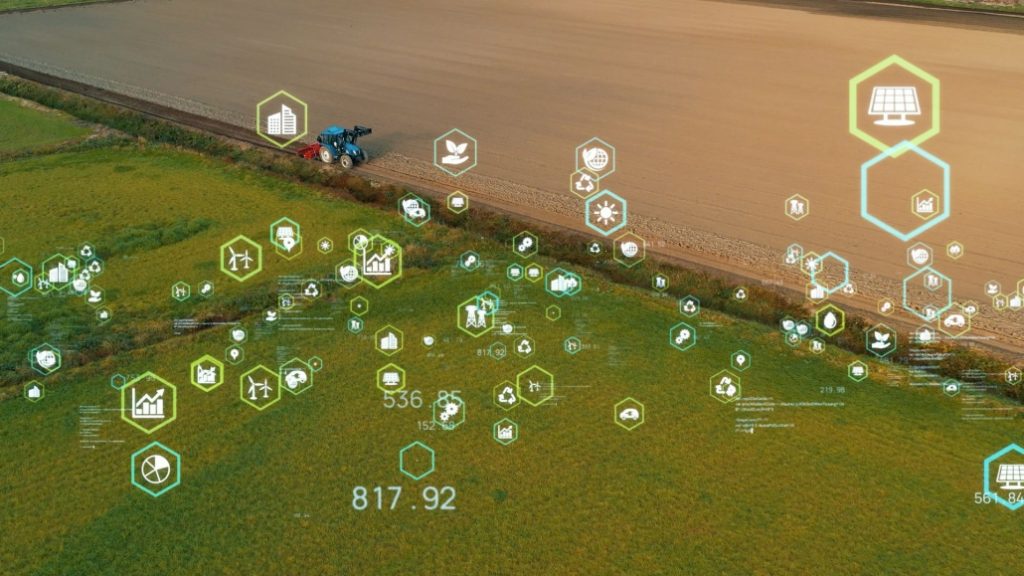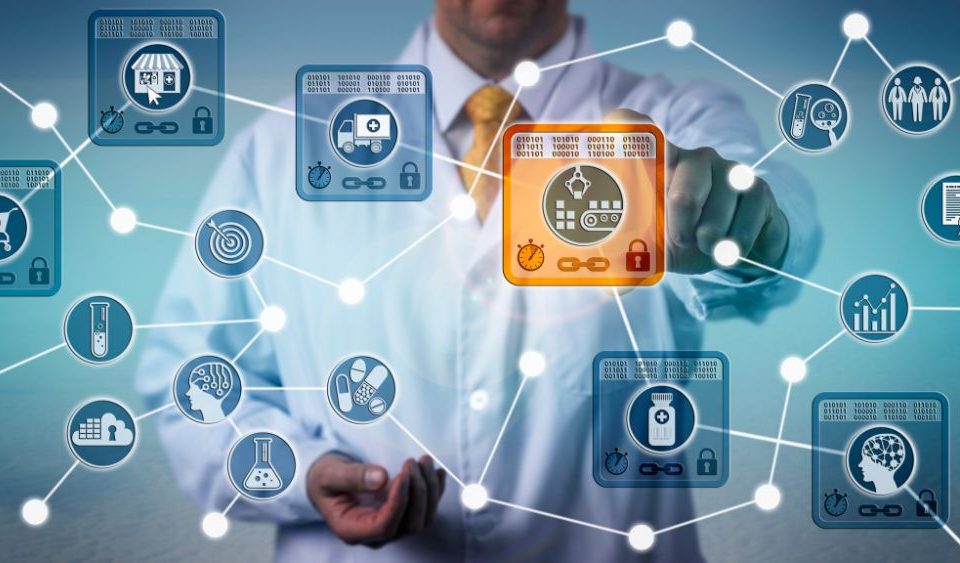How blockchain can support the common agricultural policy

Blockchain is no longer the realm of Bitcoin and cryptocurrencies. A peer-to-peer distributed ledger technology — originally developed to underpin Bitcoin — blockchain is now attracting interest from across the supply chain sector with the potential to transform how we transfer value, assure quality and even track our food provenance. This is not surprising, given the fact that blockchain is an open distributed ledger technology (DLT) that supports “smart contracts”, which are automatically executed on the blockchain.
In the agricultural sector, blockchain can be used to automatically track seeds from their “seed to harvest”, eliminate the need for excessive paperwork, ensure transparency, minimize errors and create a better landscape for the future, as well as potentially reduce or even eliminate the need for government subsidies. It can also support better food safety and better access to local and seasonal produce, as well as fostering an integrated and vibrant agricultural sector by making cross-border trade easier and more efficient.
However, to realize these benefits, a number of barriers will need to be overcome and solutions implemented.
First, data collection is critical. How can a country or an institution prove the provenance of a food crop? In other words, how can it prove what seed was grown where and when and in what season? This means that storage and protection of agricultural information needs to be improved to eliminate duplication of effort and to safeguard its authenticity. The growing demand for data and analytical tools for modern and sustainable farming is also an area ripe for innovation in the blockchain space.
Second, the agricultural sector will need the right toolkit to deliver on the promises of blockchain. While an open source ecosystem is part of blockchain’s DNA, a tightly curated, controlled and defined ecosystem is needed to build business value from DLT in agriculture. The right tooling for information sharing and smart contracts is in high demand by the sector and will only grow in value. To this end, specialist software platforms that provide the requisite level of functionality, low total cost of ownership and flexibility are essential.
Third, blockchain cannot be just about the application of smart contracts and information sharing. Unless blockchain is understood in the context of a strong and credible ecosystem of use cases, business risks will remain high and further implementation is uncertain.
Means Mangrovia‘s platform Brandzledger, we have been advising the agricultural sector for some time on how to take advantage of DLT to deliver improved performance and efficiency in the supply chain. We are a blockchain based offering of cloud-services, with a stated mission to support our members in developing their digital strategies and, ultimately, their digital transformation. We strongly believe that blockchain is a future-proof technology with the potential to deliver tremendous benefits for industry.
In particular, we will be highlighting the potential for DLT to provide a consistent source of secure, digitized information — information which could underpin the efficient allocation of resources, improve traceability and security and potentially reduce risk. This process of evaluation, innovation and adoption is crucial for the sector to ensure that the benefits of blockchain and DLT are fully understood and effectively implemented.
What is blockchain?
Distributed ledger technology (DLT) refers to the decentralized network of computers that makes up a blockchain. These nodes work together to verify and record the transfer of information, forming a record that cannot be changed without the consensus of all the members of the network. Because of this, the blockchain is designed to be incorruptible, and as such it is resilient against hack attacks.
Blockchain is at the core of cryptocurrency, a digital currency that can be exchanged directly with other users without a financial intermediary. While some bitcoin enthusiasts use cryptocurrency to fund investment and speculation, others use it as a way to bypass banks and state regulations.
The strength of blockchain is that it is safe, private and easy to use. Once information has been recorded on a blockchain it cannot be edited. And because the record is not maintained in a central location, there is no possibility for the data to be corrupted.
The blockchain is a continually growing and linked list of records in the form of ‘blocks’, each containing a timestamp and a reference to the previous block. The data in any given block cannot be altered without altering all subsequent blocks, which requires consensus across the network majority. Agriculture will soon become a key industry for blockchain-powered solutions.
How blockchain will affect the Common Agricultural Policy
The European agriculture sector is beset by inefficiencies that make it difficult for farmers to sell their produce at the best prices. It is a competitive market that relies on farmers selling their produce to low-cost suppliers and buyers buying the produce at a level that allows them to recoup the cost of production, before they reinvest in expanding their farm enterprise.
It is in the interests of the EU, as a major player in world trade, to ensure that this competitive market works as efficiently as possible. This is not only important from a consumer’s point of view, but also because the cost of the EU’s farmers to compete on the world market is high.
The common agricultural policy (CAP) is responsible for maintaining a substantial level of price support for EU farmers, which has helped provide a level playing field for them across the world. As a consequence, the price levels in the EU are higher than many of their European trading partners. countries, which is both unfair and unsustainable. However, Europe has been working with the member states on its new Future of Farming policy, which aims to close this pricing gap.
Blockchain and distributed ledgers hold out the promise of doing just that. In this context, it is a perfect fit for the agricultural sector because it will improve overall cost efficiency and put in place sustainable and cost-effective ways to encourage investment in agricultural production.
Right now, the CAP is working to empower farmers through accessing finance for their production, ensuring fair treatment in terms of pricing in the internal market and providing statistical data in real time.
The CAP is making other changes too. For the first time, it will have a dedicated blockchain observatory, which will provide open-source solutions to ensure that data arising from the CAP is available in the correct format, at the relevant time and in real-time. Over *1 million farmers are already entering data into the CAP Single European Market Information System (SEMIS), which is used to monitor the impact of EU regulation on agri-food production. Agri-food companies are also helping to monitor compliance by feeding data into SEMIS too.
Blockchain could make all this easier still by providing “trust” across global supply chains through its use of cryptography. The distributed ledger technology will enable the CAP to store data in ‘blocks’, which can be trusted electronically. This will help ensure that all trading partners are exchanging reliable data. The blockchain could also potentially help with provenance tracking, environmental services payments and identifying counterfeit products.
The potential of DLT to secure and reduce fraud in the supply chain is currently factoring into its development in the CAP. It can help reduce fraud and misuse of fertilizers, reduce food waste and, among other things, increase farmer access to finance.
Farmers currently only receive their payments at harvest time, often with up to a month’s delay in receiving it. This significantly reduces farmer investment and payment security. Blockchain allows farmers to make instant payments with the help of digital technology.
Efficiency, Transparency & Security
A new business model, based on direct deposit and the use of smart devices, is expected to increase the efficiency and transparency of the payment system by more than 20 percent, while providing farmers with more security than the current system.
In addition, blockchain can assist with verifying that imports are compliant with regulations before they are allowed onto the EU market. The same technology could also help to trace the origin of foods, which is needed to protect food security and increase consumer confidence.
This will allow the use of globally recognized traceability systems, helping to improve trust across borders.
What is the potential for financial services on a blockchain?
Many blockchain-based start-ups have established themselves in the fintech space with a goal of introducing blockchain into the mainstream financial system, in a way that increases competition in financial services.
The small number of lenders that now service small and medium-sized businesses around the world is causing an imbalance in the sector. Therefore, by introducing DLT, we could help to create new, innovative financial services, especially those that aim to provide more loans to SMEs and help to create an interconnected financial system.
Brandzledger offers supply chain services that leverage the benefits of blockchain technology. It has already built a blockchain-enabled supply chain for the agrifood sector, which helps to combat fraud, improve transparency and create trust within the supply chain.
Brandzledger’s expert data science team can implement an equivalent solution for any industry or sector. Its platform supports the management of payments, transactions and payments across all stages of an agricultural production process. It is designed to scale efficiently with any number of farms or processors. The system is currently in trial stage for a number of producers in Europe.
The systems uses a blockchain and digital ledger, which is encrypted, with smart contracts and encrypted information stored on a decentralised network of machines. The encrypted information cannot be altered, nor can new information be added without consensus, which is the very principle behind blockchain technology.
Farmers will no longer have to open bank statements to check transactions, which will greatly improve transparency within the supply chain, bringing about trust between suppliers and buyers. There are other potential benefits too, such as the ability to establish traceability in the food supply chain and better price discovery in the open market. Blockchain can also provide real-time data to aid producers and processors to monitor the production process. This information could be used to monitor natural disasters, for instance, and help producers deal with extreme weather conditions or other unforeseen events.
Such a revolution could make it easier to track production throughout the supply chain, and ensure that companies are only selling the right food to the right people. This would ensure more secure, more effective and safer food production.
Whether food security is at risk, or food is too expensive, blockchain will make it possible to ensure that food is delivered to the right place at the right time at the lowest cost.
As blockchain technology continues to develop, we will surely see it be used for many more use cases in the agriculture industry. These solutions will help address the challenges facing the food industry, and the industry itself is developing its own solutions that seek to utilise the technology to benefit both farmers and processors.
Supporting an ever-growing industry
Through Brandzledger’s partnerships with smallholder farmers and other supply chain participants from across Europe, those from different countries can connect directly, allowing them to trade farm commodities on an open market as well as exchange information about farming practices amongst themselves. Brandzledger has created a solution that assists smallholder farmers in the integration of smart technology into their business, increasing their production and increasing income levels through productivity and sustainability improvements.
This will have a positive impact on the broader agricultural sector, as the increased productivity of smallholder farms will improve the overall productivity of the sector as a whole. In turn, this will help to reduce food losses in the supply chain, and will increase transparency throughout the supply chain, reducing fraud and improving consumer confidence. The platform also provides key data points about the health of the farming industry that the larger sector can use to influence legislation and promote best practices, such as climate change adaptation and waste reduction.
The future of food lies in creating relationships between producers and consumers at every level, which will allow the sector to become more sustainable, efficient and accessible. This will lead to a healthier and more sustainable food system, which will improve the lives of our children and the lives of future generations to come.
Over the next five years, Mangrovia Blockchain Solutions will focus on expanding its presence across Europe, delivering new solutions that will support both smallholder farmers and processors. The aim of Brandzledger is to create an ecosystem of farmers from across Europe that are able to connect and trade directly with processors and the wider industry, which will allow smallholder farmers to become more sustainable, efficient and accessible to the market.
The success of blockchain technology in the agri-food sector is not only limited to increased transparency and trust, but to the potential impact it could have on the wider supply chain. Blockchain technology can potentially add more accuracy and speed to food production, while also reducing waste and the time taken to deliver it to the market.
The advent of IoT technology will also mean that monitoring systems can be created for each of the steps of the supply chain, ensuring that no section is being bypassed. This is an exciting time for agri-food manufacturers, as they look to technology to help optimise their production processes, and stay ahead of the competition.
Mangrovia is looking forward to the arrival of blockchain in the agri-food sector, and is ready to work with local producers to help them take advantage of the benefits it can offer. Its solutions will allow farmers to have greater access to markets, and consumers to receive the best possible products at a reasonable price.
Summary
Blockchain has a big role to play in helping to bring about greater transparency, trust and efficiency within the agricultural sector, which is why Brandzledger has started to focus on this area of industry. By supporting farmers to share data, the technology is helping to ensure that the benefits of Blockchain technology are realised throughout the entire supply chain. It is vital that there is a trusted, transparent supply chain that allows farmers to plan and develop sustainable food production. The technology is also crucial in creating new revenue streams, by creating access to new and lucrative markets.
The more that food products are traceable from source to end of life, the more they can be able to track the impact they have on the environment and ensure that they are more sustainable for consumers. By creating an ecosystem of farmers that are able to connect and trade directly with processors, Brandzledger can support smallholder farmers who face significant obstacles when trading. As Mangrovia continues to work with farmers and processors to scale, its hope is to create a system of digital trust that is built upon secure blockchain technology. This would allow farmers to increase their income, and ensure that the food they produce is not only safer, but more sustainable and accessible to the wider industry.
Contacts:
+39 02 45391390




